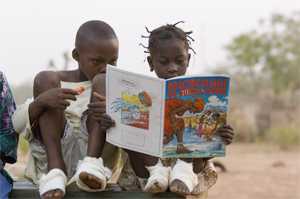Guinea Worm Eradication Program at CDC

While at the containment center in Ghana two children look at a picture book about Guinea worm disease. Credit: The Carter Center
The global campaign to eradicate Guinea worm disease (GWD) began in 1980 at the Centers for Disease Control (CDC). CDC suggested that the eradication of GWD (also known as dracunculiasis) would be an ideal indicator to measure the success of the United Nations’ International Drinking Water Supply and Sanitation Decade (1981-1990) because people can only get GWD by drinking contaminated water. In 1984, the World Health Organization Collaborating Center for Research, Training, and Eradication of Dracunculiasis (WHOCC) was established at CDC. In 1986, the World Health Assembly adopted a formal resolution calling for the eradication of GWD and the Guinea Worm Eradication Program (GWEP) was born. The Carter Center became the lead organization in this global effort. They direct a coalition of partners that includes ministries of health of endemic countries, WHO, UNICEF, and CDC along with thousands of village volunteers and supervisory health staff. The GWEP continues to receive support from numerous donor agencies, foundations, institutions, and governments.

Drinking potentially contaminated water through pipe filters can prevent Guinea Worm disease. Credit: The Carter Center
Initial WHOCC activities provided information used to develop the current program. Research projects included, evaluating filter materials for straining water, studying the copepods (tiny "water fleas") involved in the Guinea worm lifecycle, testing of potential drugs to treat GWD, and assessing different chemicals that could be added to drinking water to safely kill the copepods. The WHOCC also worked with partners to develop and publish training manuals for surveillance, health education, vector control, and case containment. Over the years, CDC staff members working with the WHOCC have provided technical assistance to national GWEPs and other partners concerning program planning, training, surveillance, case searches, health education, vector control, case containment, and case management.
The WHOCC at CDC currently focuses on the following activities:
-
Monitoring and reporting the extent of GWD around the world.
The WHOCC distributes a monthly newsletter called the Guinea Worm Wrap-Up that is produced by The Carter Center with help from CDC. This newsletter summarizes the progress of the GWEP. CDC staff members have also co-authored other publications concerning the status of the GWEP, some of which can be found listed under Publications.
-
Conducting research to improve GWEP implementation in the field.
WHOCC research activities most recently include:
- 2002—Evaluation of the distribution and impact of pipe filters in Guinea worm-endemic villages in Southern Sudan
- 2004—Analysis of the Southern Sudan GWEP surveillance data to identify hot spots for disease transmission and to modify the distribution of program resources to have a greater impact
- 2004—Evaluation of the daily functioning, public perception, and effectiveness of GWD case-containment centers in Ghana and Togo
- 2005—Evaluation of the distribution and use of pipe filters with stainless steel mesh inserts in northern Ghana
- 2005–Development of a molecular test to distinguish human D. medinensis from animal species as a means to verify suspect cases and identify situations of ongoing transmission that require immediate attention from the GWEP
- 2006—Evaluation of the effectiveness of radio messages advertising the reward for GWD cases in Nigeria
- 2007—Evaluation of the low rates of successful containment and management of GWD in Ghana due to breakage of worms during the removal process
- 2011–present—Investigations and research of GWD hosts and infection in humans and dogs in Chad.
- Ongoing – Scientists at CDC partnered with the Wellcome Trust Sanger Institute to sequence the entire genome of D. medinensis as the program moves closer to global eradication. These collaborations are continuing as more in-depth evaluations of the genome are being undertaken.
-
Providing expert technical advice on all issues related to eradication of GWD.
- The WHOCC provides laboratory support for the GWEP. The use of a molecular test developed at CDC coupled with microscopic examination of specimens has proven invaluable for confirming the diagnosis of GWD. This is particularly important when suspected cases of GWD occur in areas or countries already declared free from GWD.
- CDC staff members participate in WHO-organized evaluations of the GWEP in countries that are either near to stopping GWD transmission or have already stopped transmission. Such evaluations are part of the process that countries must follow to obtain international certification of GWD-free status. CDC has participated in many of these evaluations, including ones in Benin (2006), Burkina Faso (2010), Chad (2008), Cote d’Ivoire (2013), Ghana (2011, 2014), Liberia (2006), Mali (2008), Mauritania (2006), Niger (2010, 2013), Nigeria (2007, 2010), Sierra Leone (2006), Togo (2011), and Uganda (2005).
- The WHOCC provides consultation on GWD surveillance issues. For example, the WHOCC assisted in the development of a multi-sector Water, Sanitation, and Hygiene Emergency Preparedness and Response Plan to protect people from GWD during the 2008 Africa Cup of Nations football matches in Ghana. The WHOCC also participated in international evaluations of GWD surveillance issues related to outbreaks in Ethiopia in 2008 and in Chad in 2011- 2013.
- The WHOCC participates in GWEP program review meetings with ministries of health, The Carter Center, WHO, UNICEF, and other partners.
- In 2013, WHOCC’s staff member Dr. Mark Eberhard was named as a Commission member of the International Commission for the Certification of Dracunculiasis Eradication for his expertise in and years of service regarding GWD.
The WHOCC also produced a number of guidelines and manuals used for training purposes during the early years of the GWEP.
The WHOCC works closely with several other programs at CDC, including the Neglected Tropical Diseases Team in the Parasitic Diseases Branch of the Division of Parasitic Diseases and Malaria and the WASH Away NTDs Activity in the Waterborne Disease Prevention Branch of the Division of Foodborne Waterborne and Environmental Diseases.
- Page last reviewed: February 24, 2016
- Page last updated: March 21, 2016
- Content source:


 ShareCompartir
ShareCompartir